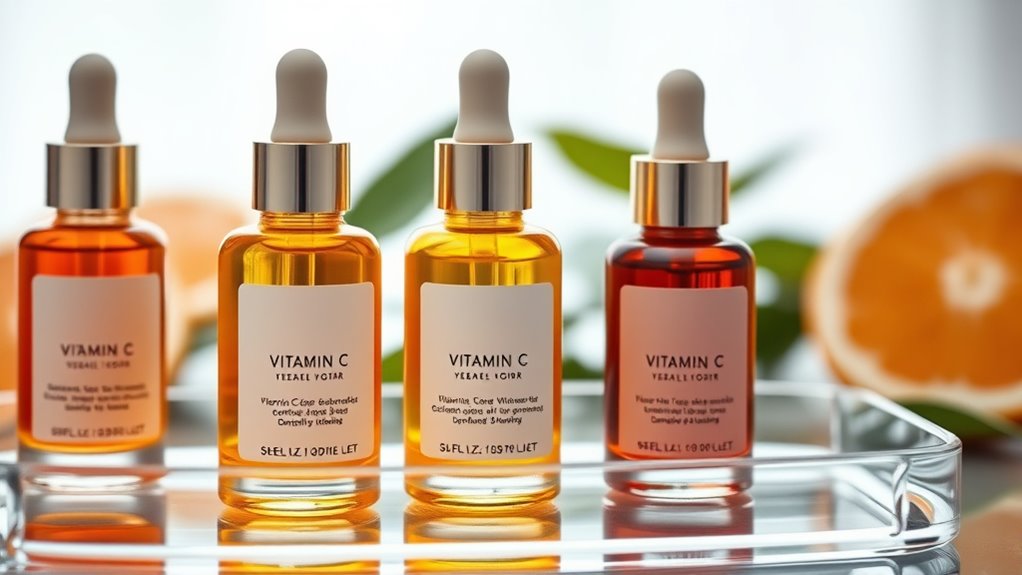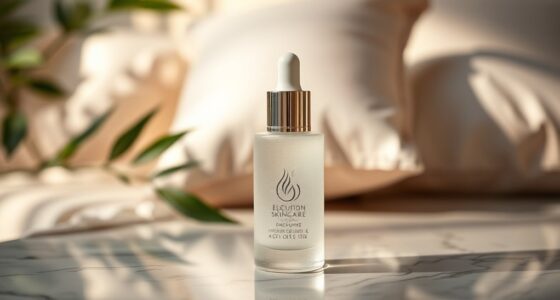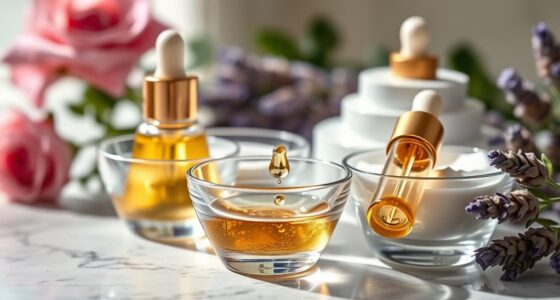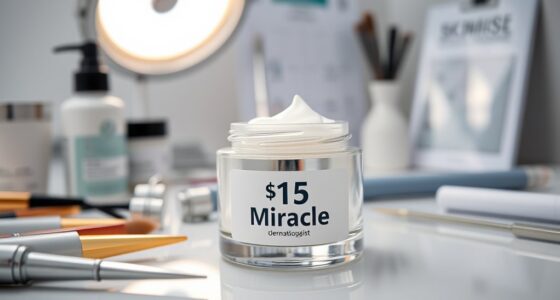Different forms of vitamin C in serums vary in stability and effectiveness. L-ascorbic acid is the most researched and potent but is less stable, requiring careful packaging and storage. Derivatives like magnesium ascorbyl phosphate or sodium ascorbyl phosphate are more stable but need to convert in your skin to work fully. To maximize benefits, choose stable, well-packaged options and learn how to properly store your serum for the best results. Keep going to discover more tips.
Key Takeaways
- L-ascorbic acid is the most effective but less stable form, prone to oxidation without proper packaging.
- Derivatives like magnesium ascorbyl phosphate and sodium ascorbyl phosphate are more stable but need skin conversion to active vitamin C.
- Proper packaging, such as dark, airtight bottles, prevents light and air exposure, preserving serum stability and potency.
- Stability of vitamin C in serums depends on formulation, storage conditions, and whether the active form is used.
- Combining vitamin C with antioxidants like vitamin E enhances stability and overall skin protection benefits.
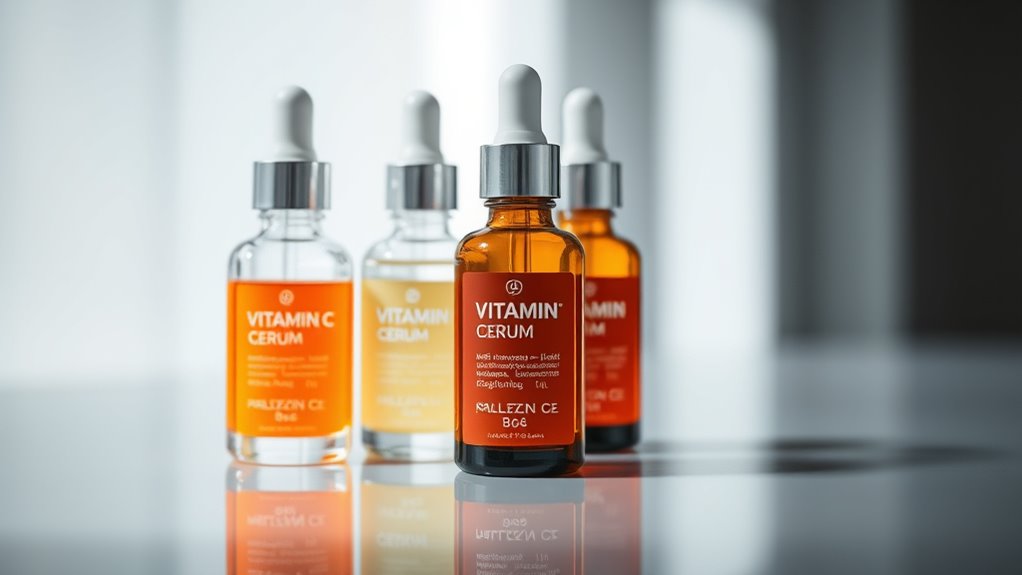
Vitamin C is a popular ingredient in skincare serums because of its powerful antioxidant properties and ability to brighten skin. When you choose a vitamin C serum, understanding how different types of vitamin C work can help you get the best results. One key factor to consider is antioxidant synergy, which refers to how well vitamin C interacts with other antioxidants like vitamin E or ferulic acid. These combinations can amplify the protective effects against environmental damage, enhancing your skin’s resilience and radiance. For example, when vitamin C is paired with vitamin E, they work together to neutralize free radicals more effectively than alone, offering greater antioxidant synergy. This synergy can improve your skin’s overall health, reduce signs of aging, and boost your complexion’s glow. Additionally, proper user consent management ensures you are informed about how your data, including your preferences for skincare products, is used and stored, aligning with privacy policies.
Vitamin C enhances skincare when paired with antioxidants like vitamin E for maximum protection and radiance.
Another vital aspect is packaging preservation. Vitamin C is notoriously unstable, especially in exposed or unsuitable containers. If your serum isn’t stored properly, it can oxidize quickly, losing potency and effectiveness. Look for serums in opaque, airtight bottles—preferably dark glass or aluminum—that prevent light and air from degrading the vitamin C. Proper packaging preserves the stability of the formula, making sure you get the full benefits. A serum that’s been exposed to air or light may appear darker or cloudy, which is a sign of oxidation. Using products in well-designed packaging helps maintain the serum’s potency over time, making sure you’re applying a fresh, effective formula every time.
The stability of vitamin C in serums depends heavily on its form. For example, L-ascorbic acid is the most researched and effective type, but it’s also less stable and more prone to oxidation. To combat this, many brands incorporate stabilizers or use derivatives like magnesium ascorbyl phosphate or sodium ascorbyl phosphate, which are more stable but may require conversion in the skin to become active. When selecting a serum, consider not just the type of vitamin C but also how it’s formulated and stored. The right packaging and combination with other antioxidants can make a significant difference in how well the vitamin C performs and how long it remains effective.
Ultimately, choosing a vitamin C serum with good antioxidant synergy and proper packaging preservation ensures you maximize its brightening and anti-aging benefits. When you pay attention to these factors, you’re more likely to enjoy consistent, noticeable results and protect your skin from daily environmental stressors.
Frequently Asked Questions
How Does Storage Affect Vitamin C Serum Stability?
Storing your vitamin C serum properly helps keep it stable. You should avoid light exposure, as sunlight can degrade the active ingredients, reducing effectiveness. Keep the serum in a cool, temperature-controlled place, like a cabinet away from heat sources, to prevent oxidation. Make sure the bottle is tightly closed after each use to minimize air contact. With proper storage, your serum stays potent and effective for longer.
Can Vitamin C Serums Cause Skin Irritation?
Imagine a gentle sunrise warming your skin; vitamin C serums can sometimes cause skin irritation, especially if you have sensitive skin. You might notice redness or a tingling sensation, which signals skin sensitivity or ingredient interactions. To avoid discomfort, start with lower concentrations, patch test first, and choose serums formulated for sensitive skin. This way, you protect your skin’s natural glow while enjoying the brightening benefits.
Are There Natural Sources of Stable Vitamin C?
Yes, you can find natural sources of stable vitamin C, like camu camu, acerola cherries, and rose hips, which naturally contain high vitamin C levels. To improve stability, these sources are often processed with methods that prevent oxidation, such as freeze-drying or encapsulation. Incorporating these into your diet or skincare routines ensures you benefit from vitamin C’s antioxidant power without risking instability or irritation.
How Long Do Vitamin C Serums Typically Last?
Vitamin C serums typically last between 3 to 6 months once opened, though this varies based on shelf life and packaging. You should look for opaque, airtight bottles, as light and air degrade the vitamin C. Proper storage in a cool, dark place extends their efficacy. Always check the expiration date and observe for color changes or separation, which indicate it’s time to replace your serum.
Can I Mix Different Types of Vitamin C in One Serum?
You can mix different types of vitamin C in one serum, but you need to take into account formulation compatibility and ingredient interactions. Not all vitamin C forms blend well, and some combinations may reduce effectiveness or cause instability. Carefully research each ingredient’s properties, or consult a skincare professional, to guarantee they work harmoniously. Mixing incompatible forms could lead to oxidation or reduced benefits, so proceed cautiously for ideal results.
Conclusion
Choosing the right vitamin C serum is like planting a delicate seed—you want it to grow strong and flourish. Knowing the different types and their stability helps you protect your investment and enjoy the bright, youthful glow you desire. Just like a gardener carefully tends to each plant, you can nurture your skin by selecting stable, effective formulas. With patience and the right choice, your skin will thrive, revealing radiant beauty that’s worth the effort.
